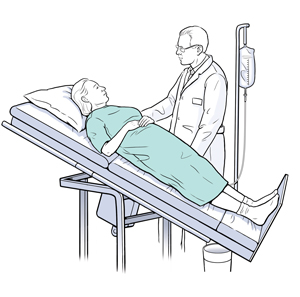Tilt Table Testing
Tilt table testing is a simple test that helps the healthcare provider find the cause of your fainting. It checks how changes in body position can affect your blood pressure and heart rate. For this test, you are placed on a table lying flat. Then the table is tilted upward (head up) to different angles. The test tries to recreate fainting symptoms while your blood pressure, heart rhythm, and heart rate are monitored. The test can be done in a hospital or at your provider's office.

Before your test
For best results, prepare for the test as advised. Keep in mind:
-
When you schedule the test, be sure to mention all the medicines you take. This includes prescription and over-the-counter medicines, vitamins, herbs, and other supplements. Ask if you are to take them the day of the test.
-
Have a family member or close friend come with you to the test so that they can give you a ride home after the test if needed
-
Follow all directions you're given for not eating and drinking before the test.
-
On the day of the test, dress for ease and comfort. Wear a 2-piece outfit, top and bottoms. You may need to undress from the waist up and put on a short hospital gown.
This test should not be done if you have severe disease affecting the vessels that carry blood to your heart (coronary artery disease) or brain (cerebrovascular disease), or if you are currently pregnant.
During your test
Tilt table testing takes about 60 minutes. The testing room is kept quiet and dimly lit. During the test:
-
Small, sticky pads (electrodes) are put on your chest to monitor your heartbeat.
-
A blood pressure cuff is put on your arm.
-
An IV (intravenous) line will be placed in your other arm. The IV line is used to give you fluids and medicine, if needed.
-
You’ll be asked to lie flat on the table. Your upper body and thighs will be held in place with soft straps. Your feet will be on a foot board.
-
Baseline vital signs are recorded. These include blood pressure, breathing rate, and pulse.
-
The table will be tilted upward (head-up) to different angles until you are almost standing upright. Let your healthcare provider know how you're feeling during the test. Your heart rate, heart rhythm, and blood pressure are continuously monitored. Any changes in these readings or any symptoms that occur are recorded.
-
You may stay upright for up to 60 minutes. In most cases, the test is over in 30 to 45 minutes.
-
Sometimes the provider may rub the artery in your neck to check for a fainting reflex.
-
In some cases, people are given certain IV medicines that stimulate the heart rate and heart pumping or cause a drop in blood pressure. These medicines may make you feel shaky or anxious. If these medicines are used, the test will be repeated.
After your test
Any medicines used during the test should leave your system in 15 minutes. If you were told to skip daily medicines before the test, ask if and when you should start taking them again. You’re likely to be sent home right after the test. It’s a good idea to have a friend or family member drive. If you fainted during the test, you may need more observation and testing. Otherwise, your healthcare provider will give instructions that may include resting for a few hours once you’re home.
Report any symptoms you have during the test
Let the healthcare provider know if you notice:
-
Feeling like you're going to faint
-
Overall weakness
-
Upset stomach (nausea)
-
Dimmed vision
-
Sweating, dizziness, or lightheadedness
-
A rapid heartbeat
-
Chest pain
-
Any other symptoms
Online Medical Reviewer:
Ronald Karlin MD
Online Medical Reviewer:
Stacey Wojcik MBA BSN RN
Online Medical Reviewer:
Steven Kang MD
Date Last Reviewed:
3/1/2024
© 2000-2025 The StayWell Company, LLC. All rights reserved. This information is not intended as a substitute for professional medical care. Always follow your healthcare professional's instructions.